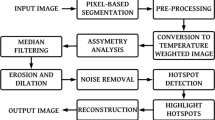Abstract
Diabetes is a chronic disease that is characterized by an increased blood glucose level due to insulin resistance. Type 2 diabetes is common in middle aged and old people. In this work, we present a technique to analyze dynamic foot pressures images and classify them into normal, diabetes type 2 with and without neuropathy classes. Plantar pressure images were obtained using the F-Scan (Tekscan, USA) in-shoe measurement system. We used Principal Component Analysis (PCA) and extracted the eigenvalues from different regions of the foot image. The features extracted from region 1 of the foot pressure image, which were found to be clinically significant, were fed into the Fuzzy classifier (Sugeno model) for automatic classification. Our results show that the proposed method is able to identify the unknown class with an accuracy of 93.7%, sensitivity of 100%, and specificity of 83.3%. Moreover, in this work, we have proposed an integrated index using the eigenvalues to differentiate the normal subjects from diabetes with and without neuropathy subjects using just one number. This index will help the clinicians in easy and objective daily screening, and it can also be used as an adjunct tool to cross check their diagnosis.







Similar content being viewed by others
References
Diabetes UK. Key statistics on diabetes. Information available at http://www.diabetes.org.uk/Professionals/Publications-reports-and-resources/Reports-statistics-and-case-studies/Reports/Diabetes-in-the-UK-2010/ (Last accessed Nov 2010)
Diabetes USA. Statistics. Information available at http://www.diabetes.org/diabetes-basics/diabetes-statistics/(Last accessed Nov 2010)
WHO Diabetes. Information available at http://www.who.int/diabetes/en/ (Last accessed Nov 2010)
Orlin, M. N., and McPoil, T. G., Plantar pressure assessment. Phys. Ther. 80:399–409, 2000.
Abouaesha, F., van Schie, C. H., Griffths, G. D., Young, R. J., and Boulton, A. J., Plantar tissue thickness is related to peak plantar pressure in the high-risk diabetic foot. Diabetes Care 4(7):1270–1274, 2001.
Greenman, R. L., Khaodhiar, L., Lima, C., Dinh, T., Giurini, J. M., and Veves, A., Foot small muscle atrophy is present before the detection of clinical neuropathy. Diabetes Care 28(6):1425–1430, 2005.
Treece, K. A., Macfarlane, R. M., Pound, N., Game, F. L., and Jeffcoate, W. J., Validation of a system of foot ulcer classification in diabetes mellitus. Diabet. Med. 21:987–991, 2004.
Caselli, A., Pham, H., Giurini, J. M., Armstrong, D. G., and Veves, A., The forefoot-to-rearfoot plantar pressure ratio is increased in severe diabetic neuropathy and can predict foot ulceration. Diabetes Care 25(6):1066–1071, 2002.
Gefen, A., Plantar soft tissue loading under the medial metatarsals in the standing diabetic foot. Med. Eng. Phys. 25:491–499, 2003.
Pataky, Z., Assal, J. P., Conne, P., Vuagnat, H., and Golay, A., Plantar pressure distribution in Type 2 diabetic patients without peripheral neuropathy and peripheral vascular disease. Diabet. Med. 22(6):762–767, 2005.
Abouaesha, F., Carine, H., van Schie, M., David, G., Armstrong, D. P. M., Andrew, J., and Boulton, M., Plantar soft-tissue thickness predicts high peak plantar pressure in the diabetic foot. J. Am. Podiatr. Med. Assoc. 94(1):39–42, 2004.
Grimm, A., Kastenbauer, T., Sauseng, S., Sokol, G., and Irsigler, K., Progression and distribution of plantar pressure in Type 2 diabetic patients. Diabet. Nutr. Metab. 17(2):108–113, 2004.
Jacob, T. V., Mothiram, P., Radhakrishnan, K., Narayanamurthy, S., and Parivalavan, V. B., The role of skin hardness, thickness, and sensory loss on standing foot power in the development of plantar ulcers in patients with diabetes mellitus – a preliminary study. Low Extrem Wounds 2(3):132–139, 2003.
Charanya, G., Patil, K. M., Narayanamurthy, V. B., Parivalavan, R., and Visnanathan, K., Effect of foot sole hardness, thickness and footwear on foot pressure distribution parameters in diabetic neuropathy. Proc. Inst. Mech. Eng. J. Eng. Med. Part H 218:431–443, 2004.
Rahman, M. A., Aziz, Z., Acharya, U. R., Tan, P. H., Natarajan, K., Ng, E. Y. K., Law, C., Subramaniam, T., and Shuen, W. Y., Analysis of plantar pressure in diabetic Type 2 subjects with and without neuropathy. Innov. Technol. Biol. Med. 27(2):46–55, 2006.
Acharya, U. R., Tan, P. H., Law, C., Tavintharan, S., Tamura, T., Chua, K. C., Ernest, G. S. C., Lim, C. M., Diana, G. S. Y., and Conrad, C. K. R., Automated identification of diabetic type 2 subjects with and without neuropathy using wavelet transform on Pedobarograph. J. Med. Syst. 32(1):21–29, 2008.
Tekscan, USA. http://www.tekscan.com/medical/system-fscan1.html (Last accessed Nov 2010)
Cavanagh, P. R., Sims, D. S., and Sanders, L. J., Body mass is a poor predictor of peak plantar pressure in diabetic men. Diabetes Care 14:750–755, 1991.
Cavanagh, P., and Ulbrecht, J., Biomechanics of the foot in diabetes mellitus. 5th ed. Year Book Inc., 1993.
Meyer, Y., Wavelets and Applications. Springer Verlag, Paris, Masson/Berlin, 1992.
Klir, G. J., and Yuan, B., Fuzzy Sets and Fuzzy Logic - Theory and Applications. Prentice Hall, NJ, USA, 1995.
Ghista, D. N., Physiological systems’ numbers in medical diagnosis and hospital cost effective operation. J. Mech. Med. Biol. 4(4):401–418, 2004.
Ghista, D. N., Nondimensional Physiological indices for medical assessment. J. Mech. Med. Biol. 9(4):643–669, 2009.
Prabhu, G. K., Patil, K. M., and Srinivasan, S., Diabetic feet at risk: A new method of analysis of walking foot pressure images at different levels of neuropathy for early detection of plantar ulcers. Med. Biol. Eng. Comput. 39(3):288–293, 2001.
See, C. K., Acharya, U. R., Kuanyi, Z., Lim, T. C., Yu, W., Tavintharan, S., and Law, C., Automated identification of diabets type 2 subjects with and without neuropathy using eigenvalues. Proc. Inst. Mech. Eng. J. Eng. Med. Part H 224(1):43–52, 2010.
Acknowledgements
The authors thank the Tote-Fund, Singapore, for supporting this project. They also thank Cheong Mun Siong Aaron and Heng Kyne Ian for helping in the development of the software.
Author information
Authors and Affiliations
Corresponding author
Rights and permissions
About this article
Cite this article
Acharya, U.R., Tong, J., Subbhuraam, V.S. et al. Computer-Based Identification of Type 2 Diabetic Subjects with and Without Neuropathy Using Dynamic Planter Pressure and Principal Component Analysis. J Med Syst 36, 2483–2491 (2012). https://doi.org/10.1007/s10916-011-9715-0
Received:
Accepted:
Published:
Issue Date:
DOI: https://doi.org/10.1007/s10916-011-9715-0




